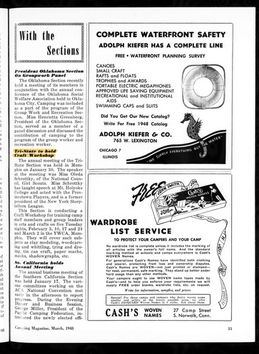With the overarching theme of creativity and cultivating creativity in children at the forefront, camp directors, educators, and counselors began to examine and define the important factors of the arts and crafts program. These inquiries and findings culminate into three sub-themes: Operating an Efficient Arts and Crafts Program, Defining and Recognizing the Value of an Arts and Crafts Program, and integrating Art in ALL Parts of Camp.
Operating an Efficient Arts and Crafts Program
Develop Their Creative Ideas (Part I)
Camping Magazine
May 1947
“No one person can carry on all available craft projects in one camp during one summer. The camp director must keep in mind what part of the crafts are to play in his camp program. Are they to be a part of a large creative program or just busy work to keep campers happy? He must then hire his counselor and allocate funds accordingly.”
“Every child likes to make things—or did until some adult discouraged him, told him he was too messy or that his work was no good. One of the most discouraging things is failure; it mustn’t happen in camp. But remember also that something that looks like a failure to you may be an experience and a thing of pride to a child. Don’t put your standards out of his reach, but keep them high. Children’s work must be childlike. Help keep it that way, but make sure the projects you have planned will meet the age and experience level of your campers.”
Develop Their Creative Ideas (Part II)
Camping Magazine
June 1947
“Success in the craft house, as well as the camp as a whole, depends on how well all plans are made ahead of time. You must be several jumps ahead of campers at all times. Their success depends on your interest in them and their projects. Enjoy their experiences with them, and the results will take care of themselves.”
How to get MORE from Your Craft Program
Camping Magazine
May 1950
“Working facilities and time allowed for crafts on most camps’ daily programs are definitely at a high level. Usually, too, there is high camper participation in crafts as they are offered. This was indicated in a recent survey of hand-craft programs in a representative group of summer camps made by the writer (Eleanor Tinsley) in obtaining data for a master's thesis. However, it was also indicated that these programs were lacking in efficient operation. Directors and counselors expressed desire for help, particularly in mechanics of operation, securing adequate counseling staff, obtaining good resource material, and program planning.”
“...with increased interest in handcrafts over the nation in the last few years more colleges and art schools are now offering work in the crafts. To achieve a truly creative handcraft program in camp it is often desirable to find counselors from the group of college or professional school upperclassmen or graduates with majors in applied design or related art, and some course work or experience in handcrafts.”
“Campers can best learn about design by being exposed to examples of good design in the craft shop.”
Basic Craft Principles
Camping Magazine
February 1952
Principles Rated Essential: safety, “head crafts counselor should be specially trained in crafts,” senior campers (14+) should be allowed to choose their own projects
Principles Rated Desirable: intermediate campers (10-13) should be able to choose their own projects, native craft materials should be used in crafts program, craft facilities should be available during ‘free periods,’ craft periods should be scheduled by age groups, crafts counselor should be same-sex of campers, junior campers (6-9) should be able to choose their own projects, crafts materials for entire season should be purchased before camp opens, power tools should be provided for senior campers
Principles Rated Useful: campers should be permitted to attend crafts only with same age group, power tools should be used by crafts counselors, awards should be given for satisfactory work in crafts, use of commercial craft kits have a place in camp, craps should provide some amount of materials at no direct cost, power tools should be provided for use of intermediate campers
Principles Rated Unnecessary: power tools should be provided for junior campers
Determine Craft Shop Needs
Camping Magazine
November 1952
“It would be most unlikely that the camp director, in beginning to check up on equipment and supplies for the next camping season, will be intimately acquainted with the details of all areas of the camp program. In the matter of equipment and supplies, the craft area is a mass of names confusing to anyone who is not working closely with it.”
“The counselor’s final report of the summer work should include in narrative or outline form: 1. Percentage of participation of total camp enrollment in crafts 2. Use of craft facilities by other camp activities 3. Popular projects—general success in carrying them out 4. Unpopular projects—possible reasons for unpopularity 5. Suggestions for improvement of bullying and fixtures, additional equipment, staff, reference material, etc.”
May 1947
June 1947
May 1950
February 1952
November 1952
Defining and Recognizing the Value of an Arts and Crafts Program
Should ACA Join NEA?
Camping Magazine
March 1948
The American Camp Association (ACA) proposed joining the National Education Association (NEA) for two primary goals: “To explore the set-up of the leading professional educational organization of the United States to see if and how organized camping might fit into the picture” and 2. “To spark our own officials and members into giving more thought to the broader educational implications of camping and possible relation of camping to recognized educational organizations"
“The philosophy of this department [crafts department at Pinecliffe Camp]—which determines the entire atmosphere of this shop, its order, and rules or on the other hand its lack of order or rules—is that crafts should be an individual adventure, work that is both serious and fun."
“The moment of the final result is indeed a great experience, but all along the way, at every step in a project, children should be encouraged to do their best or better than their former best.”
“The purpose of crafts for children should be, we believe, to teach skills in handling different materials and to encourage a love for the feel, the smell, and the possibilities presented in raw materials. They should teach respect for tools, originality, curiosity, adventuresomeness, sensitivity, and taste for the lovely, the strong, and the beautiful. To have an idea and act upon it, to see it develop, perhaps with unexpected results, is to enjoy the creative experience.”
“The arts and crafts staff must be quick-witted and clever for they all must be able to answer a host of difficulties and problems. To provide materials (always having just the right things!); to come up with new ideas in such a way that the children think they are their own and proceed with execution by themselves; to solve frustrating situations like threading the little needle eye, ending off a braided belt, showing how to salvage a cracked or lopsided clay bowl; to say, “of course, of course, it can be done let’s think of a way…!” is what the counselors do. It seems important that the children should learn that nothing is very impossible or out of reach if one approaches the aim thoughtfully, step by step, uses one’s own effort and enjoys it on the way. The craft counselors are always busy, for in the world of making things there is always more that can be done. Children’s eagerness and imagination once awakened may take you anywhere.”
“We teach values with things that have value. Somehow, in too many modern camps, arts and crafts have come to occupy a building in which a misunderstood concept that art is “doing projects” prevails…At a time in modern life when we see the creative person shrinking, the new craft shop can take its integral place; it can teach art values with experiences that have art value. In what better schoolroom that the camp can a child add so abundantly to his general fund of knowledge of natural forms?”
“If the camp environment is not used for creative growth in the arts and crafts program, no “round” experience is possible. Expert skill in making objects is a narrow view for crafts. Time for dreaming, time for the solitary child as well as the group-participating, time to feel the continuity of nature, these should be the goal of creative growth in camp.”
“Art is vital as a way of opening campers’ eyes to nature…art stirs their imagination…art is more than creation if it is properly guided—it is learning to see.”
“Art will give campers another outlet or interest, as well as causing them to look closer at nature. There is pride of accomplishment when creating a picture. Interest in art can carry over in to the winter months and enrich the camper’s entire life. Many people besides doctors and psychologists have discovered that art is health giving. It is relaxing. That alone should speak for its value.”
“If our young people lack the spirit to explore or experiment and live on borrowed materials, ideas and ready-made conceptions, we will be lost because someday we will lose even the capacity to borrow.”
“As children become acquainted with their thoughts, they use objects and materials to express them.”
“Help campers express themselves with courage and conviction of their own careful thinking about experiences.”
“How can children be creative in their daily experience? What kind of environment is needed for this kind of experience? How important is creativity as compared with other types of learning? How may the leader become more effective in helping children to be creative?”
“There is no shortage of “how-to-do-it” books on arts and crafts. What is lacking, oddly enough, is a clear statement of basic principles to guide the perplexed counselor or camp director who is convinced he is irremediably uncreative. A consistent point of view would also do much to settle the prevalent confusion in the minds of many camp people regarding the proper place of arts and crafts in the over-all camp picture.”
“However, it should not be necessary to apologize for the arts and crafts offerings of a camp or to justify their presence as a mere servant of other essential activities.”
“The arts and crafts program has a vital role of its own to play in camp. It should, if properly organized and presented, result in the satisfaction of everyone’s inborn urge to create. It can contribute effectively to the formation of a well-rounded personality. It can provide the camper of every age with pleasurable activities and wholesome, meaningful recreation while he is learning specific skills. Among other things, it may also achieve incidental release from tension and introduce the camper to useful, interesting hobbies that he may profit from later on in his leisure time. Above all, however, it should aim at imparting freely exploratory attitudes towards the creative use of many media. Its overriding purpose should be the stimulation and encouragement of self-expression.”
“In the final analysis, then, the camp program of arts and crafts should be organized to offer the widest possible variety of creative experiences within the means of camp. Materials, equipment and facilities must be adequate for all needs of the program. It should not be a stop-gap, makeshift afterthought, designed simply to present impressive window dressing to parents. As a vital and integral part of the well-balanced camp, it should never play second-fiddle to any other camp activity.”
March 1948
December 1952
February 1959
April 1953
February 1960
January 1957
Art in ALL Parts of Camp
Music and Crafts Can Go Hand in Hand
Camping Magazine
November 1950
"Have you been using musical crafts effectively in your camp program? If not, give them a real chance to work for you. Don't isolate them somewhere in your craft department under the label, 'musical crafts,' but incorporate them with other camper activities and you will attract the interest of a wide age of campers with varying degrees of musical ability. Use them in connection with dramatics, nature, or perhaps a study of the historical background of your camp area."
Make Your Craft Program an All-Camp Program
Camping Magazine
May 1951
“When planning their craft program, camp directors usually consider as vital objectives: (1) Show campers the enjoyment of creative ability, and (2) provide the satisfaction which comes with accomplishment. Two other objectives, however, are frequently overlooked. The first is: Through your craft program provide experience in using natural materials and help campers develop ingenuity by improvising tools or finding new ways of working out a project using whatever equipment is available. Attention to this particular goal will elevate craft programs from the “busy-work” class to that of a creative activity having much educational value to the camper. The second additional importance objective is: Use your craft counselors and the shop to provide a source of ideas and materials for additional camp activities.”
“Both educators and interested laymen are showing a growing awareness of the value of art as stabilizing influence in this tense atomic age. The camp director’s immediate concern is with these questions: How does the arts and crafts program fit into the overall camp picture, as it is today? Is it to be a part of the general program or apart from it? Even more to the point, to what extent can and should it be integrated with the other essential camp activities, and how can this be accomplished?”
“Its [the crafts program's] achievement should enrich and vitalize the whole activity instead of being merely an extra, added appendage.”
November 1950
May 1951
February 1960

























































































